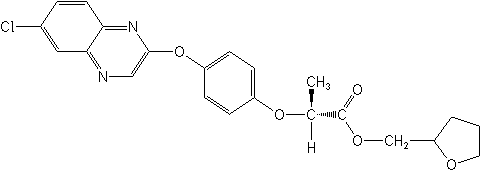-
Common NameQuizalofop-P-tefuryl
-
中文通用名喹禾糠酯
-
IUPAC(RS)-tetrahydrofurfuryl (R)-2-[4-(6-chloroquinoxalin-2-yloxy)phenoxy]propionate
-
CAS(tetrahydro-2-furanyl)methyl (2R)-2-[4-[(6-chloro-2-quinoxalinyl)oxy]phenoxy]propanoate
-
CAS No.119738-06-6
-
Molecular FormulaC22H21ClN2O5
-
Molecular Structure
-
Category
-
ActivityHerbicide
Quizalofop-P-tefuryl is classified as a Group A herbicide. It is active following post-emergence application to annual and perennial weeds. The product is systemic and is rapidly absorbed by foliage and translocated through the plant in the phloem and xylem to the meristematic tissue. There is some flexibility in the timing of the applications although for maximum benefit the weeds should be sprayed when young and actively growing; higher rates are required for mature perennial weeds. Higher application rates are also required in drought-stressed conditions. Uniroyal Chemical recommends the use of an oil concentrate adjuvant at all times to obtain optimum activity.
In field trials, quizalofop-P-tefuryl gave equal or better control of grass weeds than reference herbicides at lower rates. The product has been field tested in a range of broadleaf crops and barley. The product's efficacy against Echinochloa crus-galli and Sorghum halepense is less affected by broadleaf herbicides than standard graminicide treatments.
The product should not be applied before the five true leaf stage of the crop. It can be applied to oilseed rape prior to bud formation and stem elongation and after pod formation. -
CropUseCropUses:
Alfalfa, apples, beans, beetroot, cabbage, canola, carrots, cauliflower, chickpeas, citrus, cucumber, cotton, flax, fodder beet, grape, lettuce, lentils, linseed, melon, oilseed rape, onions, peaches, peanuts, pears, peas, peppers, potatoes, pumpkins, radish, soybeans, squash, sugar beet, sunflowers, tobacco, tomatoes, white potatoes
30-150 g ai/ha
-
Premix
Emulsifiable concentrate (EC)3% (w/v)
-
Physical PropertiesMolecular weight:428.9; Physical form:thick yellow liquid, which can crystallise upon standing at room temperature. Density:1283 kg/m3 (21.5 °C); Melting point:59-68 °C; ( tech. is a liquid); Flash point:>110 °C (Pensky-Martens); Vapour pressure:7.9 ×10-3 mPa (25 °C, gas saturation method); Henry constant:8.47 × 10-4 Pa m3 /mol- ( calc.); Partition coefficient(n-octanol and water):logP = 4.32 (25 °C); pKa:1.25 (25 °C); Solutility:In water 4 mg/l (25 °C). In toluene 652, hexane 12, methanol 64 (all in g/l).; Stability:Stable for ×14 d at 55 °C.Pure compound: white solid powder. Soluble in toluene 65.2 g/100 ml.
-
ToxicologyTech (Rat): Oral LD50 1140 mg/kg. (Rabbit): Dermal LD50 >2000 mg/kg
-
Environmental Profile
Bobwhite quail
LD50 >2,150 mg/kg
Mallard duck
LC50 >5,000 ppm
Trout [96 h]
LC50 0.51 mg/L
Sunfish [96 h]
LC50 0.23 mg/L
Fate in soil:
Quizalofop-P-tefuryl is degraded by hydrolysis in soil. It has a half-life of 8 days. The product has minimal downward movement in soil.Fate in aquatic systems:
Quizalofop-P-tefuryl undergoes photodegradation in aquatic systems. It has a half-life of 25 hours. -
Transport InformationSignal Word:CAUTION; Hazard Class:III(Slightly hazardous)
Porduct NewsMore
Arysta’s graminicides provide option to prevent new weed resistance
Quizalofop-P-tefuryl Clethodim
Related CompaniesMore
Country: China
Bentazone Bispyribac-sodium Nicosulfuron Oxadiazon Quizalofop-p-ethyl Cyhalofop-butyl Fluroxypyr-meptyl Penoxsulam Metamifop

 0
0 Subscribe
Subscribe
